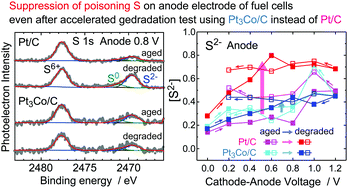Sulfur poisoning of Pt and PtCo anode and cathode catalysts in polymer electrolyte fuel cells studied by operando near ambient pressure hard X-ray photoelectron spectroscopy†
Abstract
We have investigated the S adsorption behaviours on Pt (average particle diameter of ∼2.6 nm) and Pt3Co (∼3.0 nm) anode and cathode electrode catalysts in polymer electrolyte fuel cells (PEFCs) under working conditions for the fresh state just after the aging process and also the degraded state after accelerated degradation tests (ADT), by studying near ambient pressure hard X-ray photoelectron spectroscopy (HAXPES). S 1s HAXPES of both the anode and cathode electrodes shows not only the principal S species from the sulfonic acid group (–SO3H) in the Nafion electrolyte but also other characteristic S species such as zero-valent S (S0) adsorbed on the carbon support and anionic S (S2−) adsorbed on the Pt electrode. The S2− species on Pt should be ascribed to S contamination poisoning the Pt catalyst electrode. The S2− species on the cathode can be oxidatively removed by applying a high cathode–anode bias voltage (≥0.8 V) to form SO32−, while at the anode the S2− species cannot be eliminated because of reductive environment in hydrogen gas. The important finding is the difference in S adsorption behaviours between the Pt/C and Pt3Co/C electrodes after ADT. After ADT, the Pt/C anode electrode exhibits much larger S2− adsorption than the Pt3Co/C anode electrode. This indicates that the Pt3Co/C anode is more desirable than the Pt/C one from the viewpoint of S poisoning. The reason for more tolerance of the Pt3Co/C anode catalyst against S poisoning after ADT can be ascribed to the more negative charge of the surface Pt atoms in the Pt3Co/C catalyst than those in the Pt/C one, thus yielding a weaker interaction between the surface Pt and the anionic S species as S2−, SO32−, and SO42−. A similar behaviour was observed also in the cathode catalyst. The present findings will nevertheless provide important information to design novel Pt-based PEFC electrodes with higher performance and longer durability.



 Please wait while we load your content...
Please wait while we load your content...